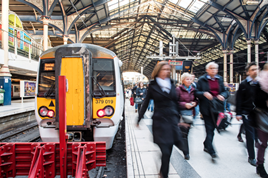Yet crossings remain a problem: “One big thing was level crossings. They are a big block to speed, but you cannot blanket close them. I managed High Speed 1 previously, so I never had them. Now there are Transport & Works Act Orders and public consultations under way. Do you know there are 137 foot crossings? That is a huge number.”
Another problem is Ipswich, which Schofield calls a “pinchpoint” in terms of capacity for freight. The Felixstowe branch needs doubling as much as is physically possible, but there are (again) level crossings and other factors to be considered, such as moving the station at Westerfield to enable the construction of a loop. Something is needed, because by 2019 there will be 47 trains per day from the port.
Beaulieu (Chelmsford) is another example where NR stands at a crossroads. A new station is proposed for the site, north of the town, but that will not help the capacity crunch south of Colchester, where it’s a two-track railway. Schofield has ideas, but no decision has yet been made.
He tells RAIL: “We have designs. It’s about getting the balances right. The developer will fund what they need, but it’s a bad place to build. It eats into capacity. The solution must be neutral capacity.”
He wonders whether Anglia trains that start and finish their journeys at Chelmsford could move there: “That frees up Chelmsford, maybe?”
What about third-party funding? NR is currently recruiting senior positions that will look to raise money for projects, but will this always be the right solution?
“It must meet the railway needs. It is about the balance. It is about pulling interested parties together.”
Performance on the Anglia network has been highlighted many times, and campaigners have regularly pointed out that infrastructure problems regularly delay trains - indeed, a signalling fault caused problems on the day of the official launch of the GA franchise.
GA’s Burles has highlighted that 60% of delays on the railway are caused by NR and 30% by GA. Naturally Schofield wants the railway to be more reliable, and he accepts it cannot be perfect. But if there are to be delays, and if NR causes those delays, he would rather the percentage of delays caused by NR to be higher if that means there are fewer overall incidents.
He has even sought counsel from outside the industry: “We are not world experts on asset reliability and so we have started working with McLaren for equipment to improve reliability.”
Schofield loves his job because of the diversity: “On one hand, there is Crossrail, but then you have the rural routes.”
He also talks with fondness of the older infrastructure. “With the right skillset you could keep the older infrastructure going.”
But he is also realistic: “CP6 may see major replacement for the swing bridges. Concrete flyovers would be an option. It is £30 million each to refurbish them . Is that the best use of taxpayer money? We will have to replace them eventually.”
He confirms that NR is implementing the Digital Railway in Anglia, but not on the Norwich-Great Yarmouth/Lowestoft routes as planned. These routes will be resignalled conventionally, and digital signalling will instead be introduced on the Chelmsford-London Liverpool Street route. This was an issue highlighted in the Commons, when Colchester MP Will Quince raised the subject during Prime Minister’s Questions on January 31 (RAIL 820).
The ongoing reliability of the railway has been questioned, and RAIL is aware that Greater Anglia is unhappy with the large number of planned closures on the railway. Schofield has an idea for the longer-term.
“Close the Great Eastern Main Line for ten days? At least for some time in the summer? It would need to have a contingency plan, but engineers then have a clear run at the railway to get it right.”
He acknowledges the problem that for many there are no diversionary routes: “If we said now we will close the railway for ten days in 2020, and then there are options, passengers will be able to make plans.”
Schofield is constantly looking forward - “with 52% growth needed, planning is the priority”, he says. At the Westminster summit on September 7, Network Rail was asked if capacity or line speed improvements would be the priority for the company. Schofield is adamant: “You can have both.”
As he looks out of his office at Stratford, he can see the city, the Olympic Stadium and (of course) the railway. He smiles: “If you were offered my job 20 years ago there was decline. The scale of the challenge is terrifying, but we will do it.”
This feature was published in RAIL 822 on 11th March 2017
















Login to comment
Comments
No comments have been made yet.